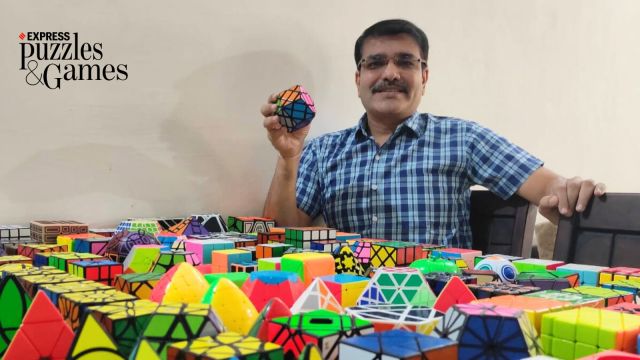In a world obsessed with digital distractions, the 50-year-old Rubik’s Cube continues to captivate enthusiasts of all ages. Celebrating its golden jubilee in 2024, this seemingly simple puzzle is an iconic symbol of patience and ingenuity. Yet, for many, the classic 3×3 cube — the world’s best-selling puzzle — is just the beginning of a much larger, confounding universe.

 Clockwise from left: Assortment of twisty puzzles; a Rubik’s Cube for the blind with Braille representing colours; and a sudoku puzzle cube. (Wikimedia Commons)
Clockwise from left: Assortment of twisty puzzles; a Rubik’s Cube for the blind with Braille representing colours; and a sudoku puzzle cube. (Wikimedia Commons)
A cuber, collector and designer of twisty puzzles, Rathod’s odyssey into this realm began serendipitously in 2019. A Rubik’s Cube purchased on a whim during an airport layover would become a life-altering experience that has since defined his free time.
“The first attempt,” he recalls, “was scary and frustrating,” a sentiment shared by many who have grappled with the cube’s enigmatic patterns. Did you know the inventor, Erno Rubik himself, took a whole month to solve it?
After overcoming the initial frustrations, fascination would push Manish deeper to explore the vast world of mechanical puzzles. Over the years, Rathod has amassed an impressive collection of over 400 of these games, among which over 100 are his own creations.
The puzzle virtuoso is the sole Indian to contribute his exclusive designs to the Twisty Puzzles Museum — a prestigious international platform that showcases unique and inventive puzzle designs. ”The recognition fills me with immense pride and motivation to continue innovating,” he says. Currently, over 40 of his creations are showcased on the platform.
Also Try | Good at logic? You’ll ace our daily Digital Sudoku challenges
In April 2024, the cubing maestro was also invited to the New York Puzzle Party, an annual summit that hosts renowned puzzle designers to present their creations. “Unfortunately, I couldn’t attend due to visa issues, but the invitation itself was an honour,” says Manish.
Story continues below this ad
Another memorable moment was when Rathod successfully solved Nintendo’s enigmatic “10 Billion Barrel” puzzle. The challenge was presented to him by a doctor friend who had been struggling to crack it. “The classic puzzle was released in 1980, and no tutorials were available online,” Manish reveals. He, however, cracked the code despite any prior exposure, and created a tutorial video that later found its way into a documentary about Nintendo.
Rathod has a “particular fondness for ghost cubes and other challenging puzzles”, relishing the journey from initial intimidation to confusion to the eventual triumph.
Riffing on the Rubik’s Cube: How does one make new puzzles?
Rathod begins by “visualizing a concept, often inspired by the desire to constantly push the boundaries of creativity and innovation”. Then, using computer-aided design (CAD) software, he brings these mental images to life, carefully considering factors like aesthetics, playability and movement.
But it’s no cakewalk. “One of the main challenges I’ve faced is my non-engineering background,” admits the commerce graduate. “I’ve had to learn things like the golden ratio and designing platonic solids from scratch.”
Story continues below this ad
For those new to this, the golden ratio is an irrational number equalling 1.618033988749894…. Found in nature and art, it also governs the surfaces of Platonic solids. Named after Plato, these solids, aka, three-dimensional structures, form the core of all twisty puzzles. A grasp of the golden ratio thus allows cube designers to decide the sizing, symmetry and movement of their twisty puzzles with ease:
 The golden ratio as a neverending spiral on a rectangle; and (right) how three such rectangles can design a twisty puzzle in the shape of a icosahedron, which has 20 faces. (Wikimedia Commons)
The golden ratio as a neverending spiral on a rectangle; and (right) how three such rectangles can design a twisty puzzle in the shape of a icosahedron, which has 20 faces. (Wikimedia Commons)
The designer community has been quick to embrace Rathod. “I’ve been fortunate to receive guidance from the kind puzzle designer community, especially from Vladi Delimollov in Bulgaria, who has been instrumental in overcoming roadblocks,” he reveals.
As an immersive hobby with a steep learning curve, cubing has also required that Rathod dedicate time to to it “before and after office hours and on weekends”. But has this helped his day-to-day in any way?
It seems so. Manish believes cubing enhances his ability to visualise situations from multiple angles, changing his perspective. “It requires using both the conscious and subconscious mind simultaneously… This dual engagement fosters focus, which is crucial as even a momentary lapse can affect the outcome,” he explains. This state of hyper-focus is what attracts many to speedcubing (whose world record, by the way, stands at 3.13 seconds):
Story continues below this ad
Looking ahead, Rathod’s mind is abuzz with possibilities — new shapes, unconventional mechanisms. “I am excited to explore new dimensions of creativity” he beams. While his upcoming projects are still under wraps, his goal remains clear: “to design puzzles that not only test skills but also spark imagination and a love for problem-solving”.
Do you know how many possible combinations a simple Rubik’s Cube has? A staggering 43 quintillion!



 Clockwise from left: Assortment of twisty puzzles; a Rubik’s Cube for the blind with Braille representing colours; and a sudoku puzzle cube. (Wikimedia Commons)
Clockwise from left: Assortment of twisty puzzles; a Rubik’s Cube for the blind with Braille representing colours; and a sudoku puzzle cube. (Wikimedia Commons) The golden ratio as a neverending spiral on a rectangle; and (right) how three such rectangles can design a twisty puzzle in the shape of a icosahedron, which has 20 faces. (Wikimedia Commons)
The golden ratio as a neverending spiral on a rectangle; and (right) how three such rectangles can design a twisty puzzle in the shape of a icosahedron, which has 20 faces. (Wikimedia Commons)





























